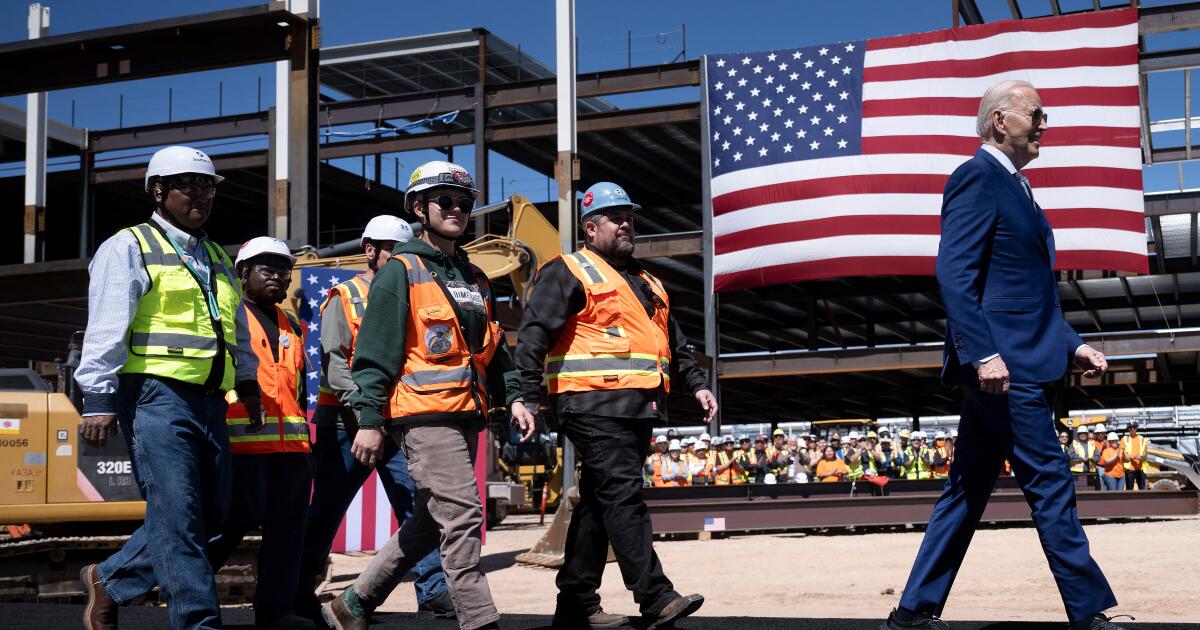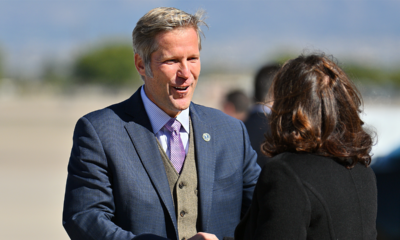Business
Arizona's economy is booming. But Biden struggles to reap benefits from voters

Aaron McDonald thinks back to when he came to Maricopa County nearly 20 years ago as a young ironworker hoping to get work building a new football stadium.
Driving in from Wyoming for the first time, he was struck by the overwhelming desert expanse that surrounded Phoenix.
Today, those sweeping vistas are dotted with industrial development that is transforming Arizona’s economy. A region that was devastated by the 2008 financial crisis is teeming with massive projects under construction, fueled in part by President Biden’s signature legislative accomplishments aimed at rebooting American semiconductor production.
“There was a shooting range there. It was the Wild West and now there’s a giant chip factory out there,” said McDonald, who now trains union ironworkers, referring to an enormous complex of plants being built in northern Phoenix by TSMC, the Taiwan Semiconductor Manufacturing Co. “The growth, to me, just really doesn’t seem like it’s gonna slow down at anytime. We know we have Biden to thank for this work.”
The question for Biden’s reelection team is whether enough voters in this battleground state will feel the same way in November.
His administration has awarded billions of dollars to companies such as Intel and TSMC and hopes that the enormous investments in green technology and semiconductors can make a difference in a state where Biden bested President Trump by a mere 10,000 votes in 2020.
But recent polling points to the challenges in winning over those voters.
The Inflation Reduction Act, the Bipartisan Infrastructure Law, and the CHIPS and Science Act will ultimately send about $24 billion to Arizona, according to data compiled by the White House.
But a majority of Americans recently surveyed nationally said they didn’t know enough to say whether the Inflation Reduction Act helped or hurt them in the two years since its passage, according to recent polling from the Associated Press-NORC Center for Public Affairs Research. And a majority of registered voters in Arizona thought Trump was “more trusted” than Biden to address the economy and immigration, a recent Bloomberg/Morning Consult poll found.
Intel has greatly expanded its operations at plants across the country including the Ocotillo campus, in part because of the CHIPS and Science Act.
(Ash Ponders / For The Times)
TSMC has committed to spending $65 billion in the state building facilities in the next decade, on top of the roughly $11 billion in loans and grants it recently received from the U.S. Department of Commerce. The company has said its new facilities, when completed, will create 6,000 permanent and roughly 20,000 temporary jobs.
“When you drive to the north, or you drive to the south, you see what my wife calls the cranes of prosperity. And they are very prominent,” said Zachary Holman, an engineering professor at Arizona State University.
Intel is similarly expanding its footprint in Arizona, where it had been pulling back its presence as recently as a decade ago. It received about $10 billion from the Commerce Department, adding to the nearly $20 billion it plans to spend to expand its presence.
But with many of the new jobs arriving years in the future, more immediate concerns such as soaring rents, rising consumer prices and the crisis at the Arizona-Mexico border are capturing most of the attention.
Trump and his allies hope things stay that way, even as they wrestle with voter anger over the state Supreme Court decision banning virtually all abortions. The Legislature voted to undo the law with some Republican support.
“Arizona voters are ready to turn out for President Donald J. Trump this November,” said Rachel Lee, a spokesperson for the Republican National Committee. “Joe Biden is losing in the state, and he knows it. Despite Biden’s best attempts to gaslight voters, they know exactly who is to blame for soaring costs, a spiraling border crisis, and staggering crime rates across the country.”

Chandler Mayor Kevin Hartke makes remarks before President Biden takes the stage during his campaign stop in the city.
(Alexandra Buxbaum / Associated Press)
Kevin Hartke, the Republican mayor of nearby Chandler, said the investment in his city has been a godsend, while noting that it has been a bipartisan boost across multiple administrations — making it hard for Biden to own this growth exclusively.
“Your common person here is going to complain more about the cost of gasoline, the effect of inflation and certainly the housing crisis,” Hartke said. “I think those areas where there is more of ‘this hits me’ concerns as people struggle to keep up with those kind of growing prices.”
In addition to expanding semiconductor production, the money has gone toward renovating Phoenix’s airport, expanding the 10 Freeway through the region and planting more trees in the city.
“The last four years have been transformational for Phoenix,” said Mayor Kate Gallego, a Democrat. “We are going to have a more diverse high-wage economy for a generation because of Biden. My job is to help people appreciate the change we’re going through and how it means that they will have more opportunities to stay here.”
This showering of money didn’t seem to register for Gabi Zander, 34, who was at a recent farmers market with her mother in Phoenix’s Uptown neighborhood. Zander, who has lived in the area for more than a decade and works in marketing, said she is focused on the rising cost of living and the war in Gaza.
The recent ruling banning virtually all abortions in the state, since overturned, angered her. But the larger state of politics has her down and she’s unsure she’ll even vote.
“I just wish politicians would spend more time thinking about how to make the city more livable and get more funding for teachers,” Zander said. “I wish they would leave us alone.”
An Emerson College poll showed Biden trailing Trump in Arizona 44% to 40%, with Robert F. Kennedy Jr. at 9%. A more recent poll from Data Orbital, a Phoenix analytics and survey firm, found Biden and Trump at 38% with Kennedy at 14%.

Steve Sherman, production engineering manager for Saras Micro Devices, it its new headquarters and production facility in Chandler.
(Ash Ponders / For The Times)
The Biden campaign has identified some combination of Arizona, Pennsylvania, Nevada, Michigan, Wisconsin and Georgia as essential to the president’s reelection.
In 2020, Biden became the first Democrat to win in Arizona since President Clinton in 1996. The last Democrat to prevail here before that was President Truman in 1948.
The state has been a player in semiconductors for decades, with Intel’s presence dating back nearly 40 years.
Companies say they are able to produce these chips far more cheaply in places like Taiwan, South Korea and Japan, but the COVID-19 pandemic and emerging tensions with China have led government and private-sector officials to revive domestic production. This was the impetus for the $52-billion CHIPS and Science Act, which Biden signed in the summer of 2022. (CHIPS stands for Creating Helpful Incentives to Produce Semiconductors.)
Much of the money — $39 billion — will come in the form of grants and tax breaks to Intel and other companies. The other $13 billion will go to research and training.
Arizona was a natural destination thanks to its open spaces and affordable land, favorable business climate and the fact that many of these companies already had a presence in the region. Intel and TSMC had already committed billions to construct new manufacturing facilities before they received government grants and tax breaks in the last year.
“Some of these companies were starting to move” to the region, said Eelco Bergman, the chief business officer of Saras Micro Devices. “I think where things like the CHIPS Act helped is they took that spark and threw some kindling on the flame.”

This Saras Micro Devices space in Georgia is moving to Arizona because of benfits from the CHIPS and Science Act.
(Ash Ponders / For The Times)
Bergman and his partners have relocated their manufacturing facility to be close to Intel’s facility in Chandler. Saras is spending close to $200 million on upgrading a building and purchasing the equipment to produce components that can be sold to semiconductor manufacturers, Bergman said.
The business ecosystem is thriving, he added, because of heavy investment and being in close proximity to schools like Arizona State University, which graduates 7,000 engineering students a year. Intel hires more people from ASU than any other school in the country, and there’s a shortage of people skilled in the disciplines necessary to work in these industries, according to the company.
However the politics ultimately play out, the region has seen a monumental shift from an economy based in real estate and tourism into one heavily layered with future-facing manufacturing. Some of the investment predated Biden, but it was supercharged during his term.
“No one is getting total credit for the big picture of the success story … because it’s happened over such a long period of time,” said Rep. Greg Stanton, a Democrat and former Phoenix mayor. “The more interesting political question is, in the short run who gets credit for the United States finally having an industrial policy that’s been missing for such a long period of time where we finally respond to the challenge that is China?
“I think President Biden is going to get appropriate credit for that. Arizona has and will better benefit from the CHIPS and Science Act than any other state,” Stanton said.
Ironworkers like those McDonald is training are bouncing from job site to job site, watching outsize warehouses and manufacturing sites rise from the desert. The work is dangerous and can be chaotic, but it’s creating a future for people like Shawna Irwin, 25, who is originally from the Navajo reservation in northeastern Arizona.
Her late uncle — an ironworker — inspired her to enter the field. She later enrolled in a training program sponsored by the Ironworkers Local 75 and run by McDonald. The roughly four-year program — sometimes called the University of Iron — has ballooned to nearly 250 ironworkers who get supplemental training as they continue to work on job sites. McDonald would like to be training 500 ironworkers at the facility he manages by 2026.
“It opened a lot of doors for the unions,” Irwin said, “and for us there was a lot more work because of [Biden] funding the chip plants.”

Business
U.S. Space Force awards $1.6 billion in contracts to South Bay satellite builders

The U.S. Space Force announced Friday it has awarded satellite contracts with a combined value of about $1.6 billion to Rocket Lab in Long Beach and to the Redondo Beach Space Park campus of Northrop Grumman.
The contracts by the Space Development Agency will fund the construction by each company of 18 satellites for a network in development that will provide warning of advanced threats such as hypersonic missiles.
Northrop Grumman has been awarded contracts for prior phases of the Proliferated Warfighter Space Architecture, a planned network of missile defense and communications satellites in low Earth orbit.
The contract announced Friday is valued at $764 million, and the company is now set to deliver a total of 150 satellites for the network.
The $805-million contract awarded to Rocket Lab is its largest to date. It had previously been awarded a $515 million contract to deliver 18 communications satellites for the network.
Founded in 2006 in New Zealand, the company builds satellites and provides small-satellite launch services for commercial and government customers with its Electron rocket. It moved to Long Beach in 2020 from Huntington Beach and is developing a larger rocket.
“This is more than just a contract. It’s a resounding affirmation of our evolution from simply a trusted launch provider to a leading vertically integrated space prime contractor,” said Rocket Labs founder and chief executive Peter Beck in online remarks.
The company said it could eventually earn up to $1 billion due to the contract by supplying components to other builders of the satellite network.
Also awarded contracts announced Friday were a Lockheed Martin group in Sunnyvalle, Calif., and L3Harris Technologies of Fort Wayne, Ind. Those contracts for 36 satellites were valued at nearly $2 billion.
Gurpartap “GP” Sandhoo, acting director of the Space Development Agency, said the contracts awarded “will achieve near-continuous global coverage for missile warning and tracking” in addition to other capabilities.
Northrop Grumman said the missiles are being built to respond to the rise of hypersonic missiles, which maneuver in flight and require infrared tracking and speedy data transmission to protect U.S. troops.
Beck said that the contracts reflects Rocket Labs growth into an “industry disruptor” and growing space prime contractor.
Business
California-based company recalls thousands of cases of salad dressing over ‘foreign objects’

A California food manufacturer is recalling thousands of cases of salad dressing distributed to major retailers over potential contamination from “foreign objects.”
The company, Irvine-based Ventura Foods, recalled 3,556 cases of the dressing that could be contaminated by “black plastic planting material” in the granulated onion used, according to an alert issued by the U.S. Food and Drug Administration.
Ventura Foods voluntarily initiated the recall of the product, which was sold at Costco, Publix and several other retailers across 27 states, according to the FDA.
None of the 42 locations where the product was sold were in California.
Ventura Foods said it issued the recall after one of its ingredient suppliers recalled a batch of onion granules that the company had used n some of its dressings.
“Upon receiving notice of the supplier’s recall, we acted with urgency to remove all potentially impacted product from the marketplace. This includes urging our customers, their distributors and retailers to review their inventory, segregate and stop the further sale and distribution of any products subject to the recall,” said company spokesperson Eniko Bolivar-Murphy in an emailed statement. “The safety of our products is and will always be our top priority.”
The FDA issued its initial recall alert in early November. Costco also alerted customers at that time, noting that customers could return the products to stores for a full refund. The affected products had sell-by dates between Oct. 17 and Nov. 9.
The company recalled the following types of salad dressing:
- Creamy Poblano Avocado Ranch Dressing and Dip
- Ventura Caesar Dressing
- Pepper Mill Regal Caesar Dressing
- Pepper Mill Creamy Caesar Dressing
- Caesar Dressing served at Costco Service Deli
- Caesar Dressing served at Costco Food Court
- Hidden Valley, Buttermilk Ranch
Business
They graduated from Stanford. Due to AI, they can’t find a job

A Stanford software engineering degree used to be a golden ticket. Artificial intelligence has devalued it to bronze, recent graduates say.
The elite students are shocked by the lack of job offers as they finish studies at what is often ranked as the top university in America.
When they were freshmen, ChatGPT hadn’t yet been released upon the world. Today, AI can code better than most humans.
Top tech companies just don’t need as many fresh graduates.
“Stanford computer science graduates are struggling to find entry-level jobs” with the most prominent tech brands, said Jan Liphardt, associate professor of bioengineering at Stanford University. “I think that’s crazy.”
While the rapidly advancing coding capabilities of generative AI have made experienced engineers more productive, they have also hobbled the job prospects of early-career software engineers.
Stanford students describe a suddenly skewed job market, where just a small slice of graduates — those considered “cracked engineers” who already have thick resumes building products and doing research — are getting the few good jobs, leaving everyone else to fight for scraps.
“There’s definitely a very dreary mood on campus,” said a recent computer science graduate who asked not to be named so they could speak freely. “People [who are] job hunting are very stressed out, and it’s very hard for them to actually secure jobs.”
The shake-up is being felt across California colleges, including UC Berkeley, USC and others. The job search has been even tougher for those with less prestigious degrees.
Eylul Akgul graduated last year with a degree in computer science from Loyola Marymount University. She wasn’t getting offers, so she went home to Turkey and got some experience at a startup. In May, she returned to the U.S., and still, she was “ghosted” by hundreds of employers.
“The industry for programmers is getting very oversaturated,” Akgul said.
The engineers’ most significant competitor is getting stronger by the day. When ChatGPT launched in 2022, it could only code for 30 seconds at a time. Today’s AI agents can code for hours, and do basic programming faster with fewer mistakes.
Data suggests that even though AI startups like OpenAI and Anthropic are hiring many people, it is not offsetting the decline in hiring elsewhere. Employment for specific groups, such as early-career software developers between the ages of 22 and 25 has declined by nearly 20% from its peak in late 2022, according to a Stanford study.
It wasn’t just software engineers, but also customer service and accounting jobs that were highly exposed to competition from AI. The Stanford study estimated that entry-level hiring for AI-exposed jobs declined 13% relative to less-exposed jobs such as nursing.
In the Los Angeles region, another study estimated that close to 200,000 jobs are exposed. Around 40% of tasks done by call center workers, editors and personal finance experts could be automated and done by AI, according to an AI Exposure Index curated by resume builder MyPerfectResume.
Many tech startups and titans have not been shy about broadcasting that they are cutting back on hiring plans as AI allows them to do more programming with fewer people.
Anthropic Chief Executive Dario Amodei said that 70% to 90% of the code for some products at his company is written by his company’s AI, called Claude. In May, he predicted that AI’s capabilities will increase until close to 50% of all entry-level white-collar jobs might be wiped out in five years.
A common sentiment from hiring managers is that where they previously needed ten engineers, they now only need “two skilled engineers and one of these LLM-based agents,” which can be just as productive, said Nenad Medvidović, a computer science professor at the University of Southern California.
“We don’t need the junior developers anymore,” said Amr Awadallah, CEO of Vectara, a Palo Alto-based AI startup. “The AI now can code better than the average junior developer that comes out of the best schools out there.”
To be sure, AI is still a long way from causing the extinction of software engineers. As AI handles structured, repetitive tasks, human engineers’ jobs are shifting toward oversight.
Today’s AIs are powerful but “jagged,” meaning they can excel at certain math problems yet still fail basic logic tests and aren’t consistent. One study found that AI tools made experienced developers 19% slower at work, as they spent more time reviewing code and fixing errors.
Students should focus on learning how to manage and check the work of AI as well as getting experience working with it, said John David N. Dionisio, a computer science professor at LMU.
Stanford students say they are arriving at the job market and finding a split in the road; capable AI engineers can find jobs, but basic, old-school computer science jobs are disappearing.
As they hit this surprise speed bump, some students are lowering their standards and joining companies they wouldn’t have considered before. Some are creating their own startups. A large group of frustrated grads are deciding to continue their studies to beef up their resumes and add more skills needed to compete with AI.
“If you look at the enrollment numbers in the past two years, they’ve skyrocketed for people wanting to do a fifth-year master’s,” the Stanford graduate said. “It’s a whole other year, a whole other cycle to do recruiting. I would say, half of my friends are still on campus doing their fifth-year master’s.”
After four months of searching, LMU graduate Akgul finally landed a technical lead job at a software consultancy in Los Angeles. At her new job, she uses AI coding tools, but she feels like she has to do the work of three developers.
Universities and students will have to rethink their curricula and majors to ensure that their four years of study prepare them for a world with AI.
“That’s been a dramatic reversal from three years ago, when all of my undergraduate mentees found great jobs at the companies around us,” Stanford’s Liphardt said. “That has changed.”
-

 Iowa6 days ago
Iowa6 days agoAddy Brown motivated to step up in Audi Crooks’ absence vs. UNI
-

 Iowa1 week ago
Iowa1 week agoHow much snow did Iowa get? See Iowa’s latest snowfall totals
-

 Maine4 days ago
Maine4 days agoElementary-aged student killed in school bus crash in southern Maine
-

 Maryland6 days ago
Maryland6 days agoFrigid temperatures to start the week in Maryland
-

 Technology1 week ago
Technology1 week agoThe Game Awards are losing their luster
-

 South Dakota6 days ago
South Dakota6 days agoNature: Snow in South Dakota
-

 New Mexico4 days ago
New Mexico4 days agoFamily clarifies why they believe missing New Mexico man is dead
-

 Nebraska1 week ago
Nebraska1 week agoNebraska lands commitment from DL Jayden Travers adding to early Top 5 recruiting class




















